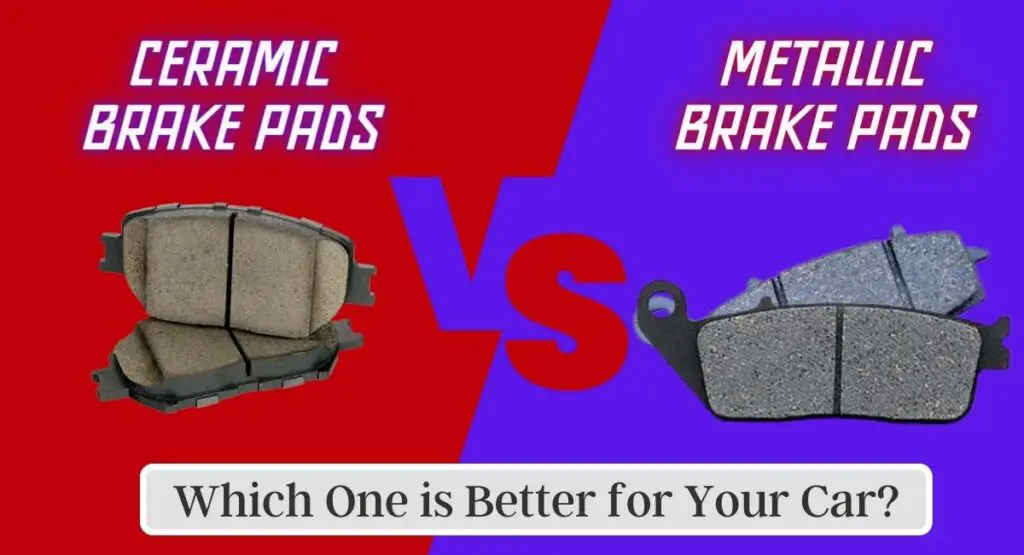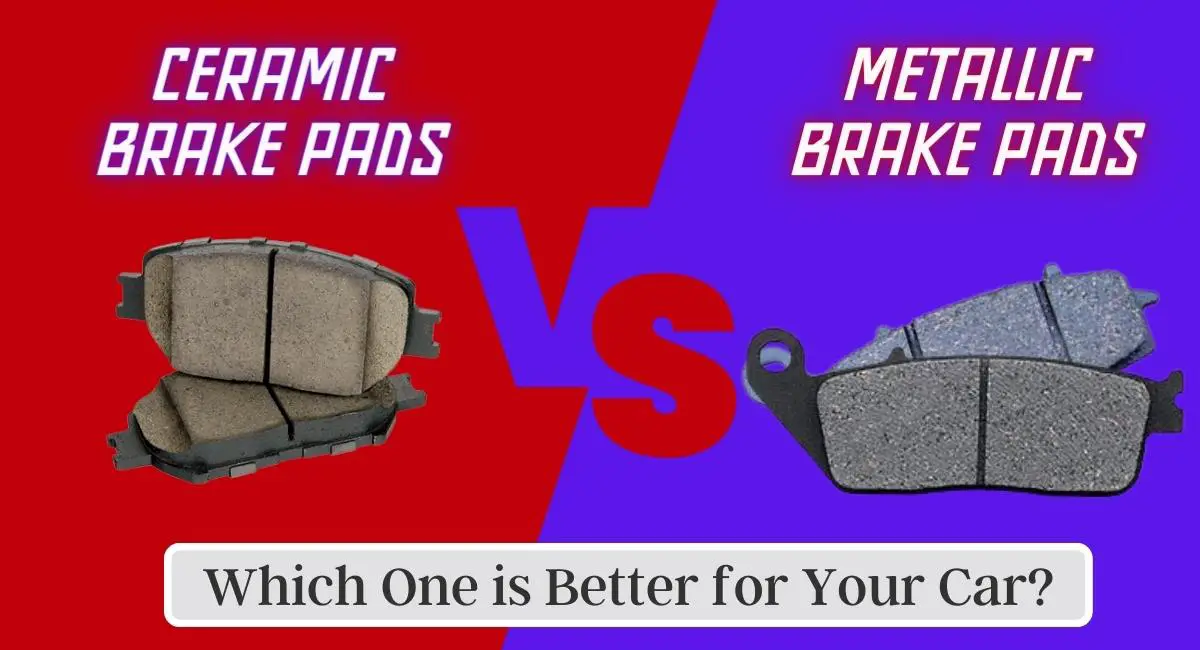When you strike the brake pedal, the brake pads are crucial in causing the car to stop or slow. These small but mighty parts convert kinetic energy into thermal energy, allowing vehicles to come to a controlled stop.
There are variant options for brake pads, but drivers often choose between ceramic and metallic options. Metallic and ceramic brake pads are known to have quieter operation than organic or semi-metallic variants.
Ceramic brake pads reduce brake dust, producing a cloud of lighter-colored dust less prone to wheel adherence. Furthermore, ceramic brake pads boast a longer lifespan when compared to organic or semi-metallic options, attributed to the unique compounds in the friction material.
You must understand these brake pads’ composition, construction, performance characteristics, noise, dust, wear comparison, and cost analysis, which are essential for making informed vehicle maintenance and safety decisions.

Composition and Construction of Ceramic Brake Pads
Although a relatively recent advancement, ceramic brake pads have rapidly emerged as the preferred material for luxury automobile brands such as Mercedes-Benz, Jaguar, Lexus, and Range Rover.
Crafted from a unique blend of non-metallic materials, ceramic brake pads undergo a transformative process akin to forging steel in the heart of a blazing furnace. Under immense pressure and searing temperatures, these materials meld together to create brake pads of unparalleled strength and resilience, ready to tackle the challenges of everyday driving with unwavering confidence.
But wait, there’s more to uncover about the composition and construction of these innovative brake pads. And there’s more on their composition and construction, let’s find out:
Composition
- Ceramic Fibers: These pads primarily comprise ceramic fibers. These fibers provide excellent heat resistance and durability.
- Non-Ferrous Filler Materials: Alongside ceramic fibers, they have non-ferrous fillers. These materials enhance the pad’s performance and contribute to its overall structure.
- Adhesives: Adhesive compounds hold the various components together, ensuring the integrity of the brake pad.
- Small Amount of Metal: Ceramic brake pads also contain a small amount of metal. This metal content may include fine copper fibers, which enhance friction and heat conductivity.
Construction
- Layered Structure: Ceramic brake pad construction is in layers. The ceramic material forms the primary friction surface that contacts the brake rotor during braking.
- Embedded Copper Fibers: The fine copper fibers are embedded within the ceramic matrix. These fibers contribute to the pad’s performance by improving friction characteristics.
- Noise Reduction: Ceramic pads are known for their quiet operation due to their composition and design.
- Low Dust Output: Unlike some other brake pad types, such as metallic pads, ceramic pads tend to produce minimal dust.
- Suitable for High-Performance Vehicles: Ceramic brake pads work well in high-performance vehicles and racing cars that generate significant heat during braking.
Composition and Construction of Metallic Brake Pads
Metallic brake pads are a powerhouse of materials where steel, iron, copper, and graphite combine in a symphony of strength. These rugged components fuse to form brake pads that thrive in the blistering heat of high-performance environments and demanding applications.
With their metallic makeup, these pads boast unparalleled heat conductivity, guaranteeing unwavering braking performance and reliability even in the most challenging conditions.
Metallic brake pads are a crucial component of your vehicle’s braking system. Let’s explore their composition and construction:
Composition
- Metallic Compounds: These pads come from metallic compounds, including copper, nickel, and iron. The manufacturers bond these elements together through a process called sintering.
- The Sintering Process transforms a liquid compound into a complex solid compound under high pressure and heat. This process gives metallic pads their nickname: sintered pads.
- Steel Backing Plate: The brake pad includes a steel backing plate that provides structural support and stability.
- Friction Material: The friction material is bound to the surface of the steel backing plate. It is this material that contacts the brake rotor during braking.
- Other Additives: Some metallic pads may contain additional additives like titanium or other transfer materials to aid break-in and reduce noise.
Construction
- Layered Design: Metallic brake pad construction is in layers. The steel backing plate forms the base, and they place the friction material on top.
- Visible Steel Fibers: Looking closely at a metallic pad, you’ll see chopped steel fibers embedded within the friction material. These fibers enhance braking performance.
- Heat Dissipation: Metallic pad designs are for rapid heat diffusion, which helps prevent brake fade during intense braking.
- Sturdy and Durable: These pads are durable and can withstand high temperatures due to their metallic composition.
- Noise Level: Metallic pads are noisier than ceramic or organic pads.
- Wear Rates: Depending on driving conditions, vehicle weight, and speed, the wear rates of metallic pads may vary. Regular replacement is essential.
- Alert Mechanisms: Most brake pads have features to alert the driver when replacement is needed, such as central grooves or wear tabs.

What are the Benefits of Ceramic Vs Metallic Brake Pads
As much as we’ve already discussed some of the benefits of these brake pads, below is a detailed explanation to help you select the best brake pads. Drivers often have a choice between ceramic and metallic options.
Benefits of Ceramic Brake Pads
Quieter Operation
One standout advantage of ceramic brake pads lies in their silent operation. Unlike metallic brake pads, which may generate audible noise when braking, ceramic pads are engineered to minimize noise, ensuring a smoother and more serene driving experience.
Reduced Dust Accumulation
Ceramic brake pads generate less brake dust than their metallic counterparts. It means cleaner wheels and reduced maintenance efforts, making ceramic pads an excellent choice for drivers who prioritize cleanliness and aesthetics.
Consistent Performance
Ceramic brake pads offer consistent braking performance across various temperatures and driving conditions. They are less prone to brake fade, ensuring reliable stopping power even during prolonged or aggressive driving maneuvers.
More extended Lifespan
Ceramic brake pads tend to have a longer lifespan than metallic pads. The composition of ceramic materials allows for extended durability, reducing the frequency of brake pad replacements and saving drivers time and money in the long run.
But ceramic pads have less bite than semi-metallic pads. It means they may not provide the same aggressive stopping power. They are less suitable for freezing climates due to their lower heat absorbency than other friction materials. Besides, they may result in higher braking system temperatures due to their limited heat absorption.
Benefits of Metallic Brake Pads
Metallic brake pads excel in dissipating heat generated during braking. The metal composition of these pads enhances heat conductivity, preventing brake fade and maintaining consistent performance, especially in high-temperature environments.
Metallic brake pads provide strong braking force due to their metal content. They grip the brake rotor effectively, allowing quick stops and precise control, making them well-suited for high-performance driving and heavy-duty applications.
Renowned for their durability and adaptability, metallic brake pads exhibit resilience to heavy usage and accommodate diverse driving styles and conditions, ranging from urban commuting to spirited maneuvers on rugged terrain.
Moreover, metallic brake pads frequently present a more economical alternative than ceramic counterparts, appealing to drivers mindful of their budget. Despite their economical pricing, metallic pads deliver dependable braking performance and enduring durability, proving to be a prudent and cost-efficient choice for numerous drivers.
However, being composed of steel, iron, copper, and other metals, metallic pads wear out more often than ceramic pads. Additionally, they can cause more wear on your brake rotors.
Performance Characteristics
The table concisely compares the critical performance characteristics of ceramic and metallic brake pads.
| Performance Characteristic | Ceramic Brake Pads | Metallic Brake Pads |
| Noise Level | Quieter operation, minimal noise during braking | It can produce noticeable noise during braking |
| Dust Accumulation | Generates less brake dust | It may create more brake dust |
| Braking performance | Consistent braking performance across temperatures and driving conditions | Strong braking force, especially in high-performance scenarios |
| Heat Dissipation | Good heat dissipation properties | Superior heat dissipation, less prone to brake fade |
| Lifespan | Longer lifespan, less frequent replacements | Durable, suitable for heavy use |
| Cost | Typically, higher initial cost, potentially offset by a more extended lifespan | Lower initial cost, cost-effective option |
| Compatibility | Compatible with most vehicles and brake systems | Compatible with most vehicles and brake systems |
| Versatility | Suitable for everyday driving and light-duty vehicles, it is ideal | le for a wide range of driving styles and conditions |
Noise, Dust, and Wear Comparison
When choosing brake pads, noise, dust, and wear are essential considerations for drivers. Ceramic brake pads are celebrated for their quiet operation, producing minimal squealing or grinding noises during braking.
Additionally, ceramic pads generate less brake dust than their metallic counterparts, resulting in cleaner wheels and reduced maintenance requirements. However, it’s worth noting that ceramic brake pads may exhibit faster rotor wear under extreme driving conditions.
In contrast, metallic brake pads may produce more noise during braking due to their metallic composition. While this noise can be noticeable, it does not necessarily indicate reduced braking performance.
Additionally, metallic brake pads generate more brake dust, which can accumulate on wheels and brake components over time. Despite this, metallic brake pads offer superior resistance to wear and can withstand heavy braking applications with minimal degradation.
Cost Analysis
When evaluating the cost of brake pads, it’s essential to consider both upfront expenses and long-term savings. Ceramic brake pads typically come with a higher initial cost than metallic options.
However, their extended lifespan and reduced maintenance requirements may offset this initial investment.
Furthermore, ceramic brake pads may contribute to savings by preserving the longevity of other brake system components, such as rotors.
In contrast, metallic brake pads offer a more budget-friendly option upfront but may require frequent replacements due to wear and tear. While this can result in higher long-term costs, metallic brake pads remain popular for drivers seeking reliable performance without breaking the bank.
Which Type of Brake Pads is Best for Racing?
For racing, where high-performance braking is crucial, drivers often prefer metallic brake pads. Here’s why:
Friction and Heat Tolerance
Metallic pads can handle extreme heat generated during aggressive braking without fading.
They provide consistent friction even under intense racing conditions.
Durability
Metallic pads are robust and can withstand the demands of racing.
They resist wear and maintain performance over extended periods.
Braking Performance
Metallic pads offer excellent stopping power, allowing racers to brake later and more effectively.
They provide strong initial bite and consistent braking force.
However, metallic pads are noisier and may cause more wear on the brake rotors. If noise isn’t a concern and you prioritize performance, metallic brake pads are your best bet on the race track!
Conclusion
Deciding between ceramic and metallic brake pads hinges on driving behavior, vehicle specifications, and individual inclinations. Ceramic brake pads ensure uniform performance, reduced noise, and minimal dust buildup, rendering them well-suited for everyday driving and vehicles with lighter duty. Conversely, metallic brake pads excel in enduring high temperatures, exhibiting durability and reliability that cater to heavy-duty demands and performance-oriented driving. Whether prioritizing quiet operation and minimal maintenance or seeking maximum durability and heat resistance, both options offer reliable braking solutions tailored to the diverse needs of modern drivers.

